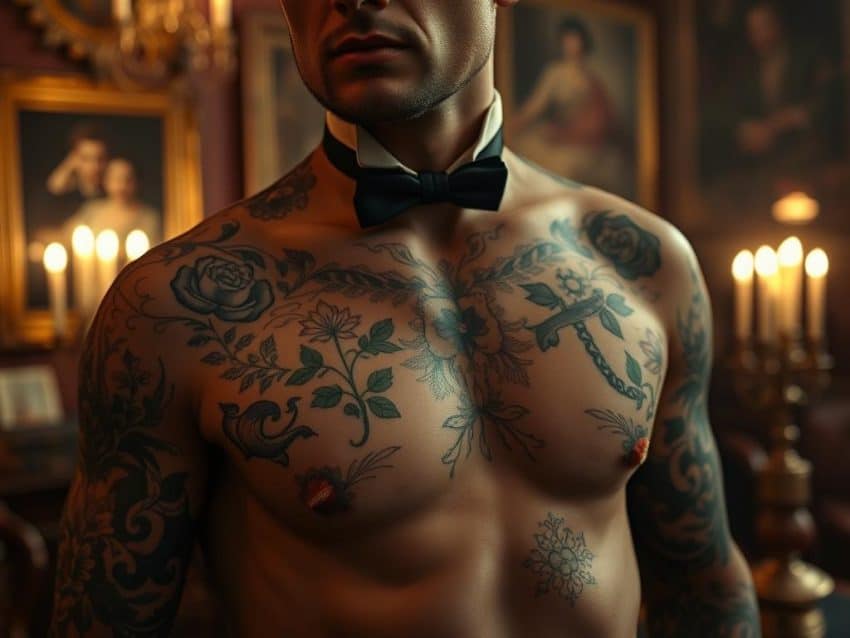Exploring Victorian tattoos, I think about my own tattoos and what they mean. Each one tells a story of who I am and where I belong. In the 19th century, tattoos were changing too. They moved from being a sign of rebellion to a symbol of elegance, loved by all.
Events like Captain James Cook’s meeting with tattooed Polynesians sparked interest in Europe. This curiosity led to a big change in tattoos, making them popular across all classes. By the mid-1800s, even British royalty was getting tattoos. This showed that tattoos were not just for the individual but also for the community.
Key Takeaways
- Victorian tattoos were a significant departure from their rebellious past, embraced by the elite.
- Social curiosity about tattoos surged following encounters with tattooed cultures.
- Royalty played a critical role in making tattoos popular in the late 19th century.
- The first tattoo parlour in London opened in the 1890s.
- Tattoos evolved as a fashionable expression across different social levels.
- By the end of the 19th century, tattoos were seen as a sign of prestige and art.
The Rise of Tattoo Culture in Victorian England
The Victorian era saw a big change in tattoo culture. This was mainly because of the royal family’s interest. Tattoos became symbols of individuality, loved by the aristocracy.
The royal family’s influence changed how people saw body art. Tattoos, once for sailors and convicts, became popular among the upper class. This showed a growing acceptance of tattoos as art.
The Influence of Royalty
Royal support meant a lot in Victorian society. When the Prince of Wales showed off his tattoos, people were curious and admired. Tattoos became a way to rebel against old norms.
They gave people a unique way to express themselves. The royals led the way, inspiring others to get tattoos.
Social Class and Access to Tattoos
Only the rich could get tattoos back then because they were expensive. Tattoos became a sign of moving away from old values.
By 1850, 25% of convicts had tattoos. But nobles had tattoos with fancy designs, unlike the lower class. This showed tattoos were becoming part of aristocratic identity, telling personal stories.
Ink in the Victorian Era: Art and Identity
The Victorian Era, from 1837 to 1901, saw a big change in tattoo culture. This time brought together art and personal expression in tattoos. Victorian tattoos became a way to show off personal stories and reflect society’s norms.
The Variety of Designs and Meanings
Victorian tattoos were full of meaning, with many designs to choose from. Each tattoo told a story, often linked to the wearer’s life. From flowers that meant love to nautical symbols for the adventurous, every tattoo had its own story.
These tattoos were deeply personal. People chose designs that showed their heritage or deep connections, adding to the emotional value of their tattoos.
Tattoos as a Form of Expression for Different Classes
In the Victorian Era, tattoos showed class differences through ink. The rich might have chosen delicate designs, while the poor went for bold symbols of their lives. This showed the gap between classes but also brought people together through shared experiences.
Each tattoo was a way to express identity, telling not just personal stories but also reflecting the society they lived in.

Conclusion
The history of tattoos shows how body art changed in Victorian England. Tattoos went from being hidden to being a sign of identity and self-expression. Women, in particular, found tattoos to be a way to show their feelings and memories, despite what others thought.
Looking back, tattoos in the Victorian era were more than just designs. They were a way for people to express who they were. With designs like roses and biblical scenes, tattoos showed a growing acceptance of self-expression. They also told stories of overcoming societal norms and challenging old beliefs.
The story of tattoos in Victorian times is complex and interesting. It shows how tattoos were seen differently back then. By looking at Victorian ink trends, we learn about the art and the society of the time. This journey from being seen as taboo to being accepted is a fascinating part of history.
